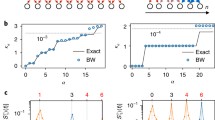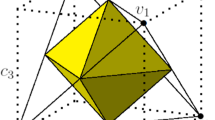Abstract
Entanglement mean field theory is an approximate method for dealing with many-body systems, especially for the prediction of the onset of phase transitions. While previous studies have concentrated mainly on applications of the theory on short-range interaction models, we show here that it can be efficiently applied also to systems with long-range interaction Hamiltonians. We consider the (quantum) Lipkin–Meshkov–Glick spin model, and derive the entanglement mean field theory reduced Hamiltonian. A similar recipe can be applied to obtain entanglement mean field theory reduced Hamiltonians corresponding to other long-range interaction systems. We show, in particular, that the zero temperature quantum phase transition present in the Lipkin–Meshkov–Glick model can be accurately predicted by the theory.
Similar content being viewed by others
References
Lewenstein M., Sanpera A., Ahufinger V., Damski B., SenDe A., Sen U.: Ultracold atomic gases in optical lattices: mimicking condensed matter physics and beyond. Adv. Phys. 56, 243 (2007)
Amico L., Fazio R., Osterloh A., Vedral V.: Entanglement in many-body systems. Rev. Mod. Phys. 80, 517 (2008)
Sachdev S.: Quantum Phase Transitions. Cambridge University Press, Cambridge (1999)
Chakrabarti B.K., Dutta A., Sen P.: Quantum Ising Phases and Transitions in Transverse Ising Models (Lecture Notes in Physics Monographs). Springer, Berlin (1996)
Osterloh A., Amico L., Falci G., Fazio R.: Scaling of entanglement close to a quantum phase transition. Nature 416, 608 (2002)
Osborne T., Nielsen M.A.: Entanglement in a simple quantum phase transition. Phys. Rev. A 66, 032110 (2002)
Mattis D.C.: The Many-Body Problem World. Scientific, Singapore (1993)
Mahan G.D.: Many-Particle Physics. Scientific, New York (2000)
Wen X.-G.: Quantum Field Theory of Many-Body Systems. Oxford University Press, Oxford (2004)
Ziman J.M.: Principles of the Theory of Solids. Cambridge University Press, Cambridge (1972)
Ashcroft N.W., Mermin N.D.: Solid State Physics. Holt, Rinehert & Winston, New York (1976)
Pathria R.K.: Statistical Mechanics. Butterworth-Heinemann, Oxford (1976)
Van Vleck J.H.: On the Anisotropy of Cubic Ferromagnetic Crystals. Phys. Rev. 52, 1178 (1937)
Oguchi T.: A theory of antiferromagnetism, II. Prog. Theor. Phys. 13, 148 (1955)
Dantziger M., Glinsmann S., Scheffler S., Zimmermann B., Jensen P.J.: In-plane dipole coupling anisotropy of a square ferromagnetic Heisenberg monolayer. Phys. Rev. B 66, 094416 (2002)
Yamamoto D.: Correlated cluster mean-field theory for spin systems. Phys. Rev. B 79, 144427 (2009)
Yamamoto D.: Cluster mean-field approach including correlation effects between clusters. J. Phys.: Conf. Ser. 200, 022072 (2010)
Nonomura Y., Suzuki M.: Cluster-effective-field approximations in frustrated quantum spin systems: CAM analysis of Neel-dimer transition in the S = 1/2 frustrated XXZ chain at the ground state. J. Phys. A 27, 1127 (1994)
Fisher M.A.: Renormalization group theory: its basis and formulation in statistical physics. Rev. Mod. Phys. 70, 653 (1998)
Farnell D.J.J., Bishop R.F.: Quantum magnetism. Lect. Notes Phys. 645, 307 (2004)
Rüegg A. et al.: Z 2-slave-spin theory for strongly correlated fermions. Phys. Rev. B 81, 155118 (2010) and references therein
Schollwöck U.: The density-matrix renormalization group. Rev. Mod. Phys. 77, 259 (2005)
Verstraete F., Cirac J.I., Murg V.: Matrix product states, projected entangled pair states, and variational renormalization group methods for quantum spin systems. Adv. Phys. 57, 143 (2008)
Sen(De) A., Sen U.: Entanglement Mean Field Theory and the Curie-Weiss Law, arXiv:0911:4856
Sen(De) A., Sen U.: Cluster Entanglement Mean Field inspired approach to Criticality in Classical Systems, arXiv:1008:0965
Lipkin H.J., Meshkov N., Glick A.J.: Validity of many-body approximation methods for a solvable model : (I). Exact solutions and perturbation theory. Nucl. Phys. 62, 188 (1965)
Meshkov N., Glick A.J., Lipkin H.J.: Validity of many-body approximation methods for a solvable model:(II). Linearization procedures. Nucl. Phys. 62, 199 (1965)
Glick A.J., Lipkin H.J., Meshkov N.: Validity of many-body approximation methods for a solvable model : (III). Diagram summations. Nucl. Phys. 62, 211 (1965)
Botet R., Jullien R., Pfeuty P.: Size scaling for infinitely coordinated systems. Phys. Rev. Lett 49, 478 (1982)
Botet R., Jullien R.: Large-size critical behavior of infinitely coordinated systems. Phys. Rev. B 28, 3955 (1983)
Sarandy M.S.: Classical correlation and quantum discord in critical systems. Phys. Rev. A 80, 022108 (2009)
Ma J., Wang X., Gu S.-J.: Many-body reduced fidelity susceptibility in Lipkin-Meshkov-Glick model. Phys. Rev. E 80, 021124 (2009)
Brown W.G., Viola L.: Convergence rates for arbitrary statistical moments of random quantum circuits. Phys. Rev. Lett. 104, 250501 (2010)
Wichterich H., Vidal J., Bose S.: Universality of the negativity in the Lipkin-Meshkov-Glick model. Phys. Rev. A 81, 032311 (2010) and references therein
Sen(De) A., Sen U.: Simulating quantum dynamics with entanglement mean field theory. J. Phys.: Conf. Ser. 297, 012018 (2011)
Author information
Authors and Affiliations
Corresponding author
Rights and permissions
About this article
Cite this article
Sen(De), A., Sen, U. Entanglement mean field theory: Lipkin–Meshkov–Glick Model. Quantum Inf Process 11, 675–683 (2012). https://doi.org/10.1007/s11128-011-0279-1
Received:
Accepted:
Published:
Issue Date:
DOI: https://doi.org/10.1007/s11128-011-0279-1




